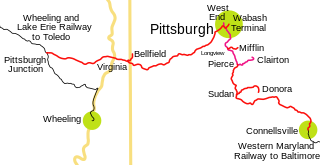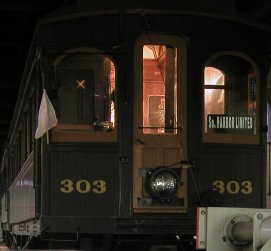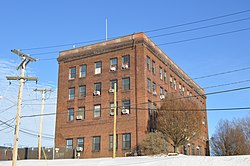The Pere Marquette Railway operated in the Great Lakes region of the United States and southern parts of Ontario in Canada. It had trackage in the states of Michigan, Ohio, Indiana and the Canadian province of Ontario. Its primary connections included Buffalo; Toledo; and Chicago. The company was named after Père Jacques Marquette S.J. (1637–1675), a French Jesuit missionary who founded Michigan's first European settlement, Sault Ste Marie.
The Lake Shore and Michigan Southern Railway, established in 1833 and sometimes referred to as the Lake Shore, was a major part of the New York Central Railroad's Water Level Route from Buffalo, New York, to Chicago, Illinois, primarily along the south shore of Lake Erie and across northern Indiana. The line's trackage remains a major rail transportation corridor used by Amtrak passenger trains and several freight lines; in 1998, its ownership was split at Cleveland between CSX Transportation to the east and Norfolk Southern Railway in the west.

Conrail, formally the Consolidated Rail Corporation, was the primary Class I railroad in the Northeastern United States between 1976 and 1999. The trade name Conrail is a portmanteau based on the company's legal name. It continues to do business as an asset management and network services provider in three Shared Assets Areas that were excluded from the division of its operations during its acquisition by CSX Corporation and the Norfolk Southern Railway.

The Great Lakes Central Railroad is an American Class II regional railroad, operating in the state of Michigan. It was originally called the Tuscola and Saginaw Bay Railway, which was formed on August 26, 1977, to operate over former Penn Central lines from Millington to Munger, and from Vassar to Colling. TSBY's name was derived from the three counties it operated in: Tuscola, Saginaw and Bay.
The Cleveland Short Line Railway is a freight bypass around southern Cleveland, Ohio, in the United States. A quasi-independent railroad organized by major shareholders of the Lake Shore and Michigan Southern Railway, the shortline was intended to allow the Lake Shore and Michigan Southern to bypass the congested railroads in downtown Cleveland. The Cleveland Short Line has had a succession of owners, and is currently part of CSX Transportation.

The Pittsburgh and West Virginia Railway was a railroad in the Pittsburgh, Pennsylvania, and Wheeling, West Virginia, areas. Originally built as the Wabash Pittsburgh Terminal Railway, a Pittsburgh extension of George J. Gould's Wabash Railroad, the venture entered receivership in 1908 and the line was cut loose. An extension completed in 1931 connected it to the Western Maryland Railway at Connellsville, Pennsylvania, forming part of the Alphabet Route, a coalition of independent lines between the Northeastern United States and the Midwest. It was leased by the Norfolk and Western Railway in 1964 in conjunction with the N&W acquiring several other sections of the former Alphabet Route, but was leased to the new spinoff Wheeling and Lake Erie Railway in 1990, just months before the N&W was merged into the Norfolk Southern Railway.
In addition to streetcar lines, the Van Sweringen Brothers of Cleveland, Ohio owned a vast network of steam railroads.
The Akron Barberton Cluster Railway is a Class III railroad that operates on 73 miles (117 km) of track in and around Akron, Ohio.

Cleveland has been and continues to be deeply rooted in railroad history.
The CL&W Subdivision is a railroad line owned and operated by CSX Transportation in the U.S. state of Ohio. The line runs from a junction with the New Castle Subdivision at Sterling northwest to Lorain along a former Baltimore and Ohio Rail Road line. It junctions with the Cleveland Subdivision at Lester and the Greenwich Subdivision at Grafton.

The P&W Subdivision is a railroad line owned and operated by CSX Transportation, the Allegheny Valley Railroad (AVR), and the Buffalo and Pittsburgh Railroad (BPRR) in the U.S. state of Pennsylvania. The line runs from Rankin north through Pittsburgh to West Pittsburg along a former Baltimore and Ohio Railroad line, once the Pittsburgh and Western Railroad.

The Pittsburgh Subdivision is an American railroad line that is owned and operated by CSX Transportation in the Commonwealth of Pennsylvania.
The Sarnia Subdivision is a railroad line owned by the Lake Erie and Detroit River Railway and operated by CSX Transportation in the Canadian province of Ontario. The line runs from Chatham north to Sarnia along a former Pere Marquette Railway line. From its north end, CSX has trackage rights west over the Canadian National Railway's Strathroy Subdivision and the Grand Trunk Western Railroad's Flint Subdivision to the CSX Port Huron Subdivision near Port Huron, Michigan, and the Saginaw Subdivision in Flint.
The Fort Wayne Line and Fort Wayne Secondary is a rail line owned and operated by the Norfolk Southern Railway (NS), Chicago, Fort Wayne and Eastern Railroad (CFE), and CSX Transportation in Pennsylvania, Ohio, and Indiana. The line runs from Pittsburgh, west via Fort Wayne, Indiana, to Gary, Indiana, along what was once the Pennsylvania Railroad's Pittsburgh to Chicago main line.

The Allegheny Valley Railroad is a class III railroad that operates in Western Pennsylvania, and is owned by Carload Express, Inc.
The Wheeling and Lake Erie Railway was a Class I railroad mostly within the U.S. state of Ohio. It was leased to the New York, Chicago and St. Louis Railroad in 1949, and merged into the Norfolk and Western Railway in 1988. A new regional railroad reused the Wheeling and Lake Erie Railway name in 1990 when it acquired most of the former W&LE from the N&W.

The Youngstown Belt Railroad is a part of the Ohio Central Railroad System, which was bought by Genesee & Wyoming Inc. in 2008, serving the area northwest of Youngstown, Ohio. It began operations in 1997, mainly on ex-Erie Railroad trackage owned by the affiliated Warren and Trumbull Railroad (W&T), which acquired the "Lordstown Cluster" from Conrail in 1996. It also leases a short ex-Baltimore and Ohio Railroad segment from CSX Transportation, formerly operated by the W&T.

Lake State Railway is a railroad operating in the Saginaw Valley and northeastern quadrant of the Lower Peninsula of Michigan. The railroad moves large quantities of aggregate and limestone, as well as coal, grain, and chemical products. Some of the company's largest customers include Dow Chemical Company, S. C. Johnson & Son, Lafarge, ConAgra Foods, Archer Daniels Midland, Conrad Yelvington Distributors, and Consumers Energy.
The Ashland Railway is a Class III railroad shortline railroad operating within North Central Ohio and based in Mansfield, Ohio. Since its inception in 1986, Ashland Railway has grown to provide service 24 hours a day 7 days a week along 55 miles of track in two segments, to industries within Ashland, Huron, Richland and Wayne counties. ASRY interchanges with the Norfolk Southern Railway in Mansfield, the Wheeling & Lake Erie Railway in Plymouth and CSX Transportation (CSXT) in Willard. The line runs southeast from Willard through Plymouth and Shelby, to Mansfield. From Mansfield the line runs northeast through Ashland and terminates in West Salem.
The Cleveland Commercial Railroad (CCR) is a shortline railroad which operates in Cuyahoga County in Ohio in the United States. Founded as a freight-only railroad in 2004, it leases and has trackage rights on lines owned by the Norfolk Southern and the Wheeling and Lake Erie Railway. It also operates an industrial switching railroad at the Port of Cleveland.








